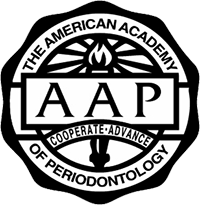


Periodontal (Gum) Disease, which is also known as periodontal disease and periodontitis, is a progressive disease which if left untreated may result in tooth loss. Gum disease begins with the inflammation and irritation of the gingival tissues which surround and support the teeth. The cause of this inflammation is the toxins found in plaque which cause an ongoing bacterial infection.
The bacterial infection colonizes in the gingival tissue and deep pockets form between the teeth and the gums. If treated promptly by a periodontist, the effects of mild inflammation (known as gingivitis) are completely reversible. However, if the bacterial infection is allowed to progress, periodontal disease begins to destroy the gums and the underlying jawbone; promoting tooth loss. In some cases, the bacteria from this infection can travel to other areas of the body via the bloodstream.
There are genetic and environmental factors involved in the onset of gum disease, and in many cases the risk of developing periodontitis can be significantly lowered by taking preventative measures.
Here are some of the most common causes of gum disease:
There are many different varieties of periodontal disease, and many ways in which these variations manifest themselves. All require immediate treatment by a periodontist to halt the progression and save the gum tissue and bone. Here are some of the most common types of periodontal disease along with the treatments typically performed to correct them:
Gingivitis is the mildest and most common form of periodontitis. It is caused by the toxins in plaque and leads to periodontal disease. People at increased risk of developing gingivitis include pregnant women, women taking birth control pills, people with uncontrolled diabetes, steroid users and people who control seizures and blood pressure using medication.
Treatment:
Gingivitis is easily reversible using a solid combination of home care and professional cleaning. The dentist may perform root planing and deep scaling procedures to cleanse the pockets of debris. A combination of antibiotics and medicated mouthwashes may be used to kill any remaining bacteria and promote the good healing of the pockets.
Chronic periodontal disease is the most common form of the disease, and occurs much more frequently in people over 45. Chronic periodontal disease is characterized by inflammation below the gum line and the progressive destruction of the gingival and bone tissue. It may appear that the teeth are gradually growing in length, but in actuality the gums are gradually recessing.
Treatment:
Unfortunately unlike gingivitis, chronic periodontal disease cannot be completely cured because the supportive tissue cannot be rebuilt. However, the dentist can halt the progression of the disease using scaling and root planing procedures in combination with antimicrobial treatments. If necessary, the periodontist can perform surgical treatments such as pocket reduction surgery and also tissue grafts to strengthen the bone and improve the aesthetic appearance of the oral cavity.
Aggressive periodontal disease is characterized by the rapid loss of gum attachment, the rapid loss of bone tissue and familial aggregation. The disease itself is essentially the same as chronic periodontitis but the progression is much faster. Smokers and those with a family history of this disease are at an increased risk of developing aggressive periodontitis.
Treatment:
The treatments for aggressive periodontal disease are the same as those for chronic periodontal disease, but aggressive periodontal disease sufferers are far more likely to require a surgical intervention. This form of the disease is harder to halt and treat, but the dentist will perform scaling, root planing, antimicrobial, and in some cases laser procedures in an attempt to save valuable tissue and bone.
Periodontal disease can be a symptom of a disease or condition affecting the rest of the body. Depending on the underlying condition, the disease can behave like aggressive periodontal disease, working quickly to destroy tissue. Heart disease, diabetes and respiratory disease are the most common cofactors, though there are many others. Even in cases where little plaque coats the teeth, many medical conditions intensify and accelerate the progression of periodontal disease.
Treatment:
Initially, the medical condition which caused the onset of periodontal disease must be controlled. The dentist will halt the progression of the disease using the same treatments used for controlling aggressive and chronic periodontal disease.
This form of the disease rapidly worsens and is more prevalent among people who suffer from HIV, immunosuppression, malnutrition, chronic stress or choose to smoke. Tissue death (necrosis) frequently affects the periodontal ligament, gingival tissues and alveolar bone.
Treatment:
Necrotizing periodontal disease is extremely rare. Because it may be associated with HIV or another serious medical condition, it is likely the dentist will consult with a physician before commencing treatment. Scaling, root planing, antibiotic pills, medicated mouth wash and fungicidal medicines are generally used to treat this form of the disease.
The objective of scaling & root planing is to remove etiologic agents which cause inflammation to the gingival (gum) tissue and surrounding bone. Common etiologic agents removed by this conventional periodontal therapy include dental plaque and tartar (calculus).
These non-surgical procedures which completely cleanse the periodontium, work very effectively for individuals suffering from gingivitis (mild gum inflammation) and moderate/severe periodontal disease.
Scaling and root planing can be used both as a preventative measure and as a stand-alone treatment. These procedures are performed as a preventative measure for a periodontitis sufferer.
Here are some reasons why these dental procedures may be necessary:
Scaling and root planing treatments are only performed after a thorough examination of the mouth. The dentist will take X-rays, conduct visual examinations and make a diagnosis before recommending or beginning these procedures.
Depending on the current condition of the gums, the amount of calculus (tartar) present, the depth of the pockets and the progression of the periodontitis, local anesthetic may be used.
Scaling: This procedure is usually performed with special dental instruments and may include an ultrasonic scaling tool. The scaling tool removes calculus and plaque from the surface of the crown and root surfaces. In many cases, the scaling tool includes an irrigation process that can also be used to deliver an antimicrobial agent below the gums that can help reduce oral bacteria.
Root Planing: This procedure is a specific treatment which serves to remove cementum and surface dentin that is embedded with unwanted microorganisms, toxins and tartar. The root of the tooth is literally smoothed in order to promote good healing. Having clean, smooth root surfaces helps bacteria from easily colonizing in future.
Following these deep cleaning procedures, the gum pockets may be treated with antibiotics. This will soothe irritation and help the gum tissues to heal quickly.
During the next appointment, the dentist or hygienist will thoroughly examine the gums again to see how well the pockets have healed. If the gum pockets still measure more than 3mm in depth, additional and more intensive treatments may be recommended.
Periodontal disease is a progressive condition which leads to severe inflammation and tooth loss if left untreated. Antibiotic treatments can be used in combination with scaling and root planing, curettage, surgery or as a stand-alone treatment to help reduce bacteria before and/or after many common periodontal procedures.
Antibiotic treatments come in several different types, including oral forms and topical gels which are applied directly into the gum pockets. Research has shown that in the case of acute periodontal infection, refractory periodontal disease, prepubertal periodontal disease and juvenile periodontal disease, antibiotic treatments have been incredibly effective.
Antibiotics can be prescribed at a low dose for longer term use, or as a short term medication to deter bacteria from re-colonizing.
Oral antibiotics tend to affect the whole body and are less commonly prescribed than topical gel. Here are some specific details about several different types of oral antibiotics:
Noticeable periodontal improvements are usually seen after systemic or oral antibiotic treatment. Your Periodontist or dentist will incorporate and recommend the necessary antibiotic treatments as necessary for the healing of your periodontal condition.
Pocket reduction surgery (also known as gingivectomy, osseous surgery and flap surgery) is a collective term for a series of several different surgeries aimed at gaining access to the roots of the teeth in order to remove bacteria and tartar (calculus).
The human mouth contains dozens of different bacteria at any given time. The bacteria found in plaque (the sticky substance on teeth) produce acids that lead to demineralization of the tooth surface, and ultimately contribute to periodontal disease.
Periodontal infections cause a chronic inflammatory response in the body that literally destroys bone and gum tissues once they invade the subgingival area (below the gum line). Gum pockets form and deepen between the gums and teeth as the tissue continues to be destroyed.
Periodontal disease is a progressive condition which, if left untreated, causes massive bacteria colonization in gum pockets can eventually lead to teeth falling out. Pocket reduction surgery is an attempt to alleviate this destructive cycle, and reduce the depth of the bacteria-harboring pockets.
Pocket reduction surgery is a common periodontal procedure which has been proven effective at eliminating bacteria, reducing inflammation and saving teeth. The goals of pocket reduction surgery are:
Before recommending treatment or performing any procedure, the dentist will perform thorough visual and x-ray examinations in order to assess the condition of the teeth, gums and underlying bone. Pocket reduction surgery may be performed under local or general anesthetic depending on the preferences of the patient.
The gums will be gently pulled back from the teeth and bacteria and calculus (tartar) will be eliminated. Scaling and root planing will generally be required to fully remove the ossification (tartar) from the surface of the tooth root. If the root is not completely smooth, a planing procedure will be performed to ensure that when the gums do heal, they will not reattach to rough or uneven surfaces.
The final part of the surgery is usually the administration of an antimicrobial liquid to eliminate any remaining bacteria and promote healing. The gum is then sutured with tiny stitches that are left in place for 5-10 days.
Though the gums will be more sensitive immediately following the procedure, there will be a significant reduction in pocket depth and a vast improvement in the condition of the teeth and gums.
Dental Implants are a great advancement in dentistry as they permanently replace missing teeth in a way that no previous dental technique was able to accomplish. Implants are anchors made out of the strongest titanium materials, that are implanted into the bone and then covered with a cap or denture. They are stronger than a natural root and will never require a root canal or filling. An implant will help maintain the health and shape of the bone in the jaw area, and neighboring teeth do not need to be filed down to make room for it.
It is imperative that the dentist performing the implant be experienced and skilled in all the proper techniques of Implant dentistry. When done successfully, an implant will result in a comfortable and natural looking tooth, thereby providing a permanent solution to a missing tooth.
If you're diagnosed with periodontal disease, your periodontist may recommend periodontal surgery. Periodontal surgery is necessary when your periodontist determines that the tissue around your teeth is unhealthy and cannot be repaired with non-surgical treatment. Following are the four types of surgical treatments most commonly prescribed:
When supporting tissue and bone is destroyed, "pockets" form around the teeth.
Your bone and gum tissue should fit snugly around your teeth like a turtleneck around your neck. When you have periodontal disease, this supporting tissue and bone is destroyed, forming "pockets" around the teeth.
Over time, these pockets become deeper, providing a larger space for bacteria to live. As bacteria develop around the teeth, they can accumulate and advance under the gum tissue. These deep pockets collect even more bacteria, resulting in further bone and tissue loss. Eventually, if too much bone is lost, the teeth will need to be extracted.
Non-surgical therapy removes plaque and calculus by controlling the growth of harmful bacteria and by treating conditions that encourage gum disease. This type of treatment may be all that's needed, especially when periodontal disease is caught early. You may also need to have certain procedures, such as replacing worn fillings or crowns with overhanging margins that can accumulate plaque, taken care of before periodontal therapy can begin.
Scaling is a type of cleaning that removes plaque and calculus from the teeth at and slightly below the gumline. Root planing smooths root surfaces, so the supportive tissues can better reattach to the tooth surface. Often, this will be done with local anesthesia so you can relax and feel nothing as we rehabilitate your gums.
Periodontal disease is a bacterial disease and the key to controlling or eliminating it is the effective reduction or elimination of the harmful bacteria. An adjunctive option to scaling and root planing may be provided in either pill form or applied directly to the infected area (gum pocket) in the form of antibiotic powder. An antibacterial mouth rinse also may be prescribed to help control the harmful effects of and reduce bacterial plaque.
An improper bite or a traumatic occlusion may increase bone destruction attached to such offending teeth. We may either choose to adjust your bite so that your teeth meet properly and function better or construct a custom bite guard or splint- a removable device that fits over upper or lower teeth - to protect teeth surfaces and relax tense jaw muscles.
Dr. Russo is the Past President of the Southern Academy of Periodontology.
John Russo's Practice has been recognized as a top Sarasota Dentistry practice in 2021.
Congratulations to the entire team!
Dr. Russo is a member of the American Academy of Periodontology and on the Board of Trustees


